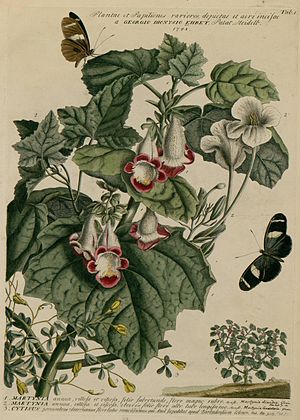Note: This is a project under development. The articles on this wiki are just being initiated and broadly incomplete. You can Help creating new pages.
Difference between revisions of "Martynia annua - Tiger's claw"
(→Chemical Composition) |
|||
| Line 8: | Line 8: | ||
==Chemical Composition== | ==Chemical Composition== | ||
| − | Qualitative phyto-chemical analysis of whole plant extracts of Martynia annua reveals the presence of glycosides, tannins, carbohydrates, phenols, flavonoids and anthocyanins | + | Qualitative phyto-chemical analysis of whole plant extracts of Martynia annua reveals the presence of glycosides, tannins, carbohydrates, phenols, flavonoids and anthocyanins.<ref name="chemical composition"/> |
==Common names== | ==Common names== | ||
Revision as of 11:28, 12 May 2021
Martynia annua which is commonly known as cat's claw, tiger's claw, or iceplant. However, the name 'iceplant' may also refer to members of the unrelated plant family Aizoaceae.
Contents
- 1 Uses
- 2 Parts Used
- 3 Chemical Composition
- 4 Common names
- 5 Properties
- 6 Habit
- 7 Identification
- 8 List of Ayurvedic medicine in which the herb is used
- 9 Where to get the saplings
- 10 Mode of Propagation
- 11 How to plant/cultivate
- 12 Commonly seen growing in areas
- 13 Photo Gallery
- 14 References
- 15 External Links
Uses
Epilepsy, Inflammation, Sore, Throat, Burns, Itching, Skin affections, Tuberculosis.
Parts Used
Chemical Composition
Qualitative phyto-chemical analysis of whole plant extracts of Martynia annua reveals the presence of glycosides, tannins, carbohydrates, phenols, flavonoids and anthocyanins.[1]
Common names
| Language | Common name |
|---|---|
| Kannada | ಹುಲಿ ಉಗುರು Huli Uguru,ಗರುಡ ಮೂಗು ಮುಳ್ಳು Garuda Mugu Mullu,ಹುಲಿ ನಖ Huli Nakha |
| Hindi | हाथाजोड़ी Hatha-jori,बाघनख Baghnakh,Hathajori,उलट-कांटा Ulat-kanta |
| Malayalam | Pulinakham,Kakka-chundu,പുലിനഖം Puli-nakham |
| Tamil | Chappotta |
| Telugu | Sima ippacettu |
| Marathi | NA |
| Gujarathi | NA |
| Punjabi | NA |
| Kashmiri | NA |
| Sanskrit | काकनसा Kakanasa |
| English | Tiger-claw,Tiger's claw,Snake's head,Devil's claw |
Properties
Reference: Dravya - Substance, Rasa - Taste, Guna - Qualities, Veerya - Potency, Vipaka - Post-digesion effect, Karma - Pharmacological activity, Prabhava - Therepeutics.
Dravya
Rasa
Guna
Veerya
Vipaka
Karma
Prabhava
Habit
Identification
Leaf
| Kind | Shape | Feature |
|---|---|---|
| Simple | Cordiform | Opposite-decussate, Acute / Cordate, Sinuate |
Flower
| Type | Size | Color and composition | Stamen | More information |
|---|---|---|---|---|
| Bisexual | Large | purple with yellow throat | In axillary or terminal racemes, Flowering throughout the year. | {{{5}}} |
Fruit
| Type | Size | Mass | Appearance | Seeds | More information |
|---|---|---|---|---|---|
| An ovoid drupe | 2 apical curved beaks spilitting into 2 valves; seeds oblong | Mature Fruit Colour is Brown | {{{6}}} |
Other features
List of Ayurvedic medicine in which the herb is used
Where to get the saplings
Mode of Propagation
How to plant/cultivate
Erect subshrubs to 1 m tall, glandular-hairy all over. Leaves 8-20 x 6-19 cm, broadly ovate to suborbicular, base cordate, margin sinuate-dentate, apex acute, chartaceous, palmately 5-nerved from base; petiole 8-14 cm long. Racemes 7-14- flowered, at the bifurcations of the branches; peduncle 4-8 cm long; pedicel 1-2 cm long; bracts 1-2 x 0.7-1 cm, broadly ovate, pale pink. Calyx lobes 5, greenish-white, 9-12 mm long; ovate-oblong. Corolla reddish-purple with yellow throat; tube 3-4 cm long; lobes rounded. Stamens 2; filaments white, c. 1 cm long; anther cells disjunct, superposed, longitudinally coherent with the opposite pair; staminodes 3. Fruits drupaceous, ovoid, flattened somewhat dorso-ventrally, ribbed, viscid-pubescent; endocarp 2-3 cm long, hard, black, with a hooked spine at tip.[3]
Commonly seen growing in areas
Lowland forest, Coastal forests.
Photo Gallery
References
External Links
- Ayurvedic Herbs known to be helpful to treat Epilepsy
- Ayurvedic Herbs known to be helpful to treat Inflammation
- Ayurvedic Herbs known to be helpful to treat Sore
- Ayurvedic Herbs known to be helpful to treat Throat
- Ayurvedic Herbs known to be helpful to treat Burns
- Ayurvedic Herbs known to be helpful to treat Itching
- Ayurvedic Herbs known to be helpful to treat Skin affections
- Ayurvedic Herbs known to be helpful to treat Tuberculosis
- Herbs with Flower used in medicine
- Herbs with Seed pods used in medicine
- Herbs with common name in Kannada
- Herbs with common name in Hindi
- Herbs with common name in Malayalam
- Herbs with common name in Tamil
- Herbs with common name in Telugu
- Herbs with common name in Sanskrit
- Herbs with common name in English
- Habit - Long shurb
- Index of Plants which can be propagated by Seeds
- Index of Plants which can be propagated by Cuttings
- Herbs that are commonly seen in the region of Lowland forest
- Herbs that are commonly seen in the region of Coastal forests
- Herbs




